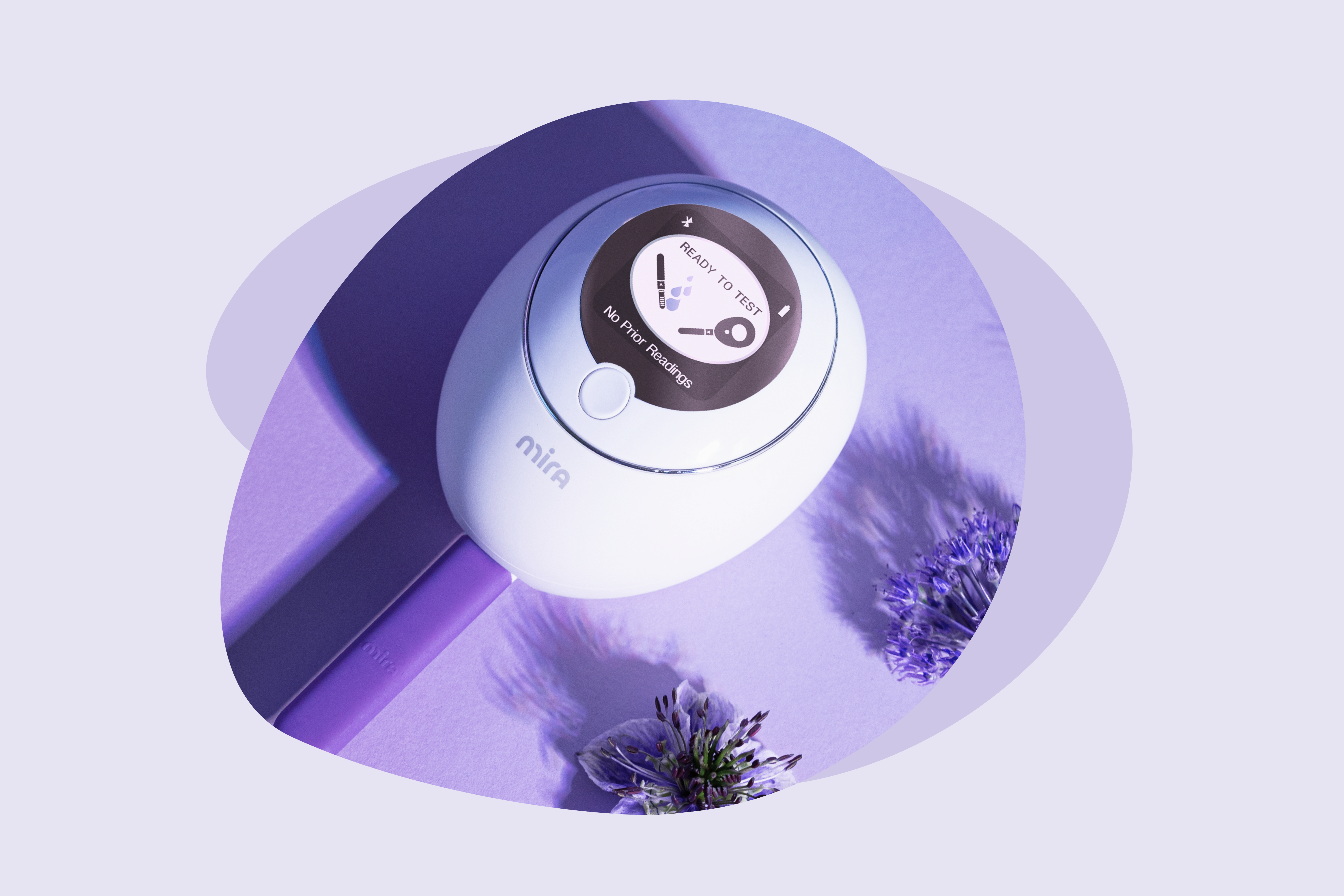The Science of Hormone Tracking: 5 Proven Facts About Mira Technology

Over 100,000 people have already chosen to use Mira’s Hormone Monitor to help guide their fertility journey.
Why? Because Mira uses lab-grade technology backed by science.
In this article, we’ll let the research speak for itself. Read on to learn four science-backed facts about the Mira system.
About Mira
If you’re not familiar with Mira’s technology – here’s a quick recap.
Mira is a palm-sized, FSA/HSA-qualified testing system that can measure key fertility hormones and their metabolites in urine. This includes luteinizing hormone (LH), estrone-3-glucuronide (E3G), pregnanediol glucuronide (PdG), and follicle-stimulating hormone (FSH).
By tracking these hormones over time, individuals can gain insights into their fertile window, ovulation patterns, and general reproductive health.
Fact #1: The accuracy of the Mira Monitor is high and comparable to professional lab equipment.
We know that fertility hormones are produced by the body, circulated through the bloodstream, and then metabolized and released in urine.
Traditionally, the only way to measure an individual’s exact hormone levels was through blood testing at a doctor’s office. With Mira, however, research suggests that hormone levels can be just as accurately measured in urine.
The Mira Fertility Max wand demonstrates remarkable accuracy in fertility hormone detection within urine—boasting detection rates of 99.5% for LH, 99.0% for E3G, and 99.5% for PdG.
This makes it a reliable tool for identifying the fertile window and predicting ovulation. With the Mira Monitor, users get precise and accurate hormonal results—with low levels of testing errors and variations.
High precision and accuracy of the Mira Monitor was confirmed with the leading laboratory-grade reader (Abbott ARCHITECT i2000SR). The LH measurements showed high correlation (r^2 > 0.9). Mira’s cutting-edge technology shows good performance with acceptable variation (<2% Coefficient of Variation) — making it an accurate and perfect choice for those who need the best for their fertility journey.

So what does this mean for individuals and couples who are trying to conceive (TTC)?
It means getting accurate hormone readings every time, from the comfort of home: less time (and money) spent at the doctor’s office and more time spent at home gaining real-time insights into their fertility health.
Fact #2: 84% of users conceived during their first 6 cycles of using Mira.
For couples looking to plan a pregnancy, learning how to predict ovulation and time sex accordingly can help to speed the process along.
Pinpointing ovulation and the fertile window can be a bit of a challenge though – especially for individuals with irregular cycles or hormonal conditions such as polycystic ovarian syndrome (PCOS).
Even commonly used fertility awareness methods (FAMs) like the calendar method, basal body temperature (BBT) method, and cervical mucus method can lend themselves to error and misinterpretation – only adding to the frustration and uncertainty surrounding the TTC process. Ovulation predictor kits (OPKs) can also be difficult to interpret, not to mention the fact they may not work well for those who do not have a “normal” 28-day cycle.
To eliminate some of the guesswork, Mira empowers all types of individuals – even those with challenges such as PCOS, irregular cycles, and hormone imbalances – to estimate their cycle with greater accuracy compared to other fertility tracking methods. The result? Quicker timelines to conception.
In fact, the data* shows that 84% of Mira users conceived within their first 6 cycles of hormone tracking, and 94% conceived within 9 cycles. Among users with PCOS and irregular cycles, 56% and 58% were able to conceive within one year, respectively.
Among users who tested with Mira consistently (at least 70% of the recommended testing days of the cycle), these numbers are higher: 76% were able to conceive within the first 3 cycles and 95% were able to conceive within the first 6 cycles.
In another study of 89,000+ cycles, Mira’s Fertility Plus Wands were found to be 6X more accurate at predicting ovulation than the basic calendar method – suggesting that Mira is a better choice for those who are looking to conceive as efficiently as possible.
Fact #3: Mira uses fluorescent labeling technology to detect a broader range of hormones.
Mira is unique in that it can pick up on the smallest hormone changes with sensitivity and precision, allowing it to detect a broader, more dynamic range of hormones in the body.
Unlike other devices (such as ovulation predictor kits) that rely on the traditional nano-gold labeled lateral flow assay, Mira’s test wands utilize fluorescent lateral flow immunoassay technology. This offers a distinct advantage in terms of sensitivity, because fluorescent molecules emit a stronger and more easily detectable signal. In turn, this enhances the detection of low concentrations of target analytes (such as hormone molecules in urine samples) – especially when used in conjunction with our lab-grade fluorescence detection device, the Mira Analyzer.
No other technology like this exists on the market, and for individuals, it revolutionizes the way they observe and track their hormones.
While nano-gold assay technology relies on visual representation (i.e. two lines compared by the human eye), fluorescent immunoassay technology provides quantitative results. For example, instead of receiving a ‘yes’ or ‘no’ answer about whether or not ovulation has occurred, individuals can now see their numeric hormone concentration measurements – and they don’t even have to set foot inside of a doctor’s office or laboratory.
When testing consistently, even the most subtle hormone changes and patterns can be detected in real-time – providing individuals with a comprehensive and accurate view of their unique hormonal health.
Fact #4: More testing = smarter predictions
Mira is trained and optimized on over 13 million hormone data points (950,000 menstrual cycles and counting!), and its technology only gets smarter as it processes more and more data.
Unlike OPKs which only work based on averages and standard thresholds, Mira’s AI technology learns everything it can about each individual user’s cycle patterns. It then analyzes this information to provide unique, personalized results that become more sophisticated over time.
The study proved that Mira AI learns personal ovulation patterns so well that (even without further hormone monitoring) ovulation prediction accuracy grows significantly.
After testing with Mira for three cycles, the ovulation prediction accuracy rate for the fourth cycle is 77% (meaning: 77% accurate before users started testing their 4th cycle).
To compare, the accuracy rate of predicting ovulation using the calendar method (before Mira monitor) is only 29%.
Fact #5: At-home testing devices like Mira help patients feel more empowered.
Between all the doctor’s appointments, doom-scrolling on Google, and unsolicited advice from friends/family, it’s no secret that the TTC process can feel overwhelming for so many.
To help, tools like Mira can eliminate some of the uncertainty surrounding hormone health and ovulation tracking.
A study conducted by the Olive Fertility Center proved that at-home hormones testing devices like Mira improve the fertility patient experience when compared with traditional clinical blood testing, which can feel invasive and insufficient.
Data shows that patients testing with Mira felt more empowered. They also preferred the discreteness of at-home monitoring.
This study also proved the accuracy of at-home urine testing during ovarian stimulation, showing a strong correlation of traditional E2 blood testing with E3G results by Mira.
By enabling users to test their hormones for themselves, Mira empowers patients to feel in complete control of their reproductive health – all from the privacy of their own home.
Learn More
If you’d like to learn more about the science behind Mira, we welcome you to check out the following resources on our website:
You can also check out our library of Mira medical studies, papers, and peer-reviewed publications.
* Disclaimer: The pregnancy rate is calculated based on Mira users’ test data and Mira users’ marking with the pregnancy status.
Mira’s Editorial Process
All content produced by Mira meets stringent editorial standards, ensuring excellence and accuracy in language and medical precision. Every piece undergoes thorough fact-checking and review by qualified professionals. Check out our full editorial process to learn more.










